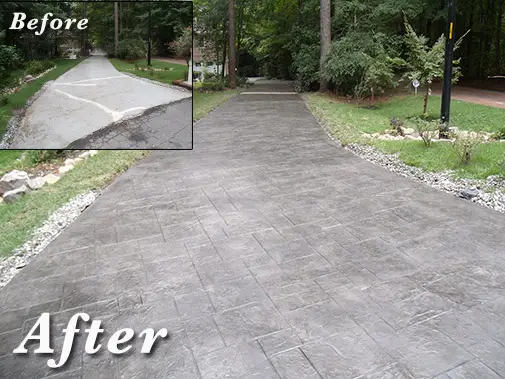Cracks, pop outs, discoloration or any other flaws on concrete shouldn’t be a headache anymore because of concrete overlay. A concrete overlay enables you cover up surface imperfections that may be present on existing concrete. It provides for an alternative to a complete removal or replacement of the concrete and the good news is that they can be of a decorative or non-decorative variety, the choice is yours! They are a good alternative to acid staining old concrete hence giving the old concrete a brand new look.
They are very versatile in nature and can be utilized with a number of coloring techniques in order to achieve a wide range of colors and effects. Normally, the concrete overlay is meant to be strong and hardy hence making it ideal for trowel stenciling, stamping, or as a primer coat on previously tiled or stamped surfaces.

In the days of old, cement-based overlays were prominent, but today, they have been blended with polymer resins, sand and other additives in a bid to improve performance, aesthetic qualities and wear resistance. With polymer-modified overlays, the application can be of a thin variety or a thick one depending on what you wish the outcome to be. In addition to not having to worry about failure when applied, the polymer-modified overlays tend to properly adhere to existing concrete and do away with damage from chemicals, salt, freeze-thaw conditions, abrasion and UV exposure.
Different manufactures make use of different mechanisms for polymer modified-overlays in a bid to produce proprietary products that posses distinct physical attributes. Ultimately, the look that you are looking for will determine the concrete overlay product that you can best use. Since they are considered highly versatile from both functional and aesthetic perspective, they do provide for long term, durable renovation minus the need for costly and constant repairs that tend to occur with deteriorating concrete surfaces.
The concrete overlay can be used both in the interior and exterior. They can be used on the patio, driveway and floor. Before it can be applied however, the intended surface has got to be prepped, meaning that it has got to be cleaned first if lasting results are to be realized.
There are different overlays out there such as:
- A sprayed on concrete overlay which comes in handy in case you need some texture on the surface for slip-resistance.
- Interior concrete overlay for resurfacing interior floors or exterior patios for that flowing, even finish or polished appearance.
- Self-Leveling concrete overlay which is meant to fix a floor that is not leveled.
At the end of the day, you can use concrete overlay to work on a number of projects. You can use it to repair concrete, for decorative stamping, ultra thin toppings, staining and leveling floors that are pitched the wrong way or which are tipped. They can be applied by homeowners themselves, although practice of the same is recommended before commencing on the actual surface to be worked on. This can be done on old useless concrete or hard board. It is best however to leave the overlaying to professionals where possible.
As a tip though, it is important to realize that you may not be able to resurface all existing concrete. This is because the underlying base is meant to be sound and not have severe cracks, rest on unstable soil, or spall as result of damage from freeze-thaw cycles and deicing salts. In otherwise in case the surface you intend to apply the concrete overlay is badly cracked, powdery, settled or soft, then you might need to look into replacing it as opposed to applying the concrete overlay.

